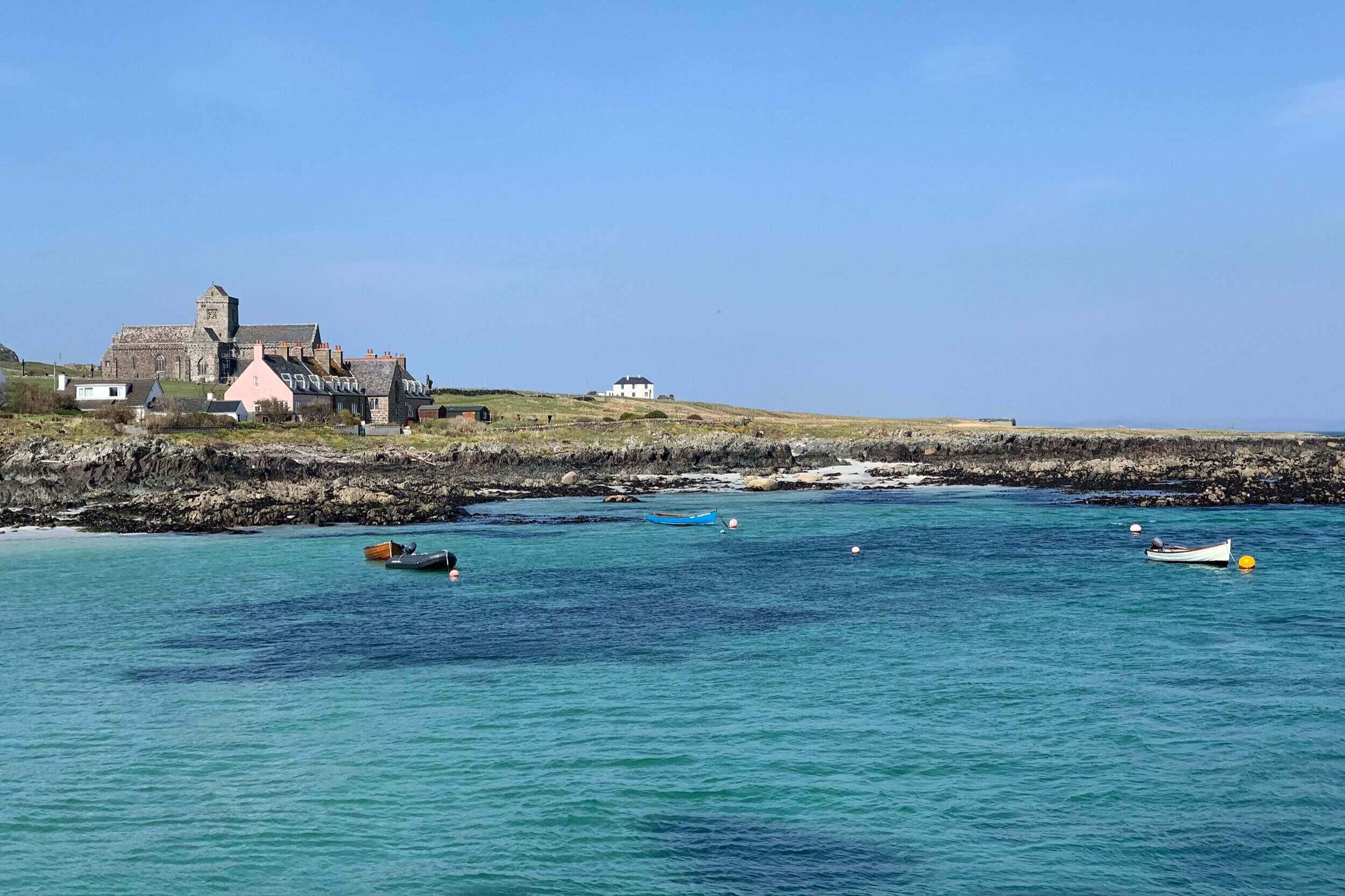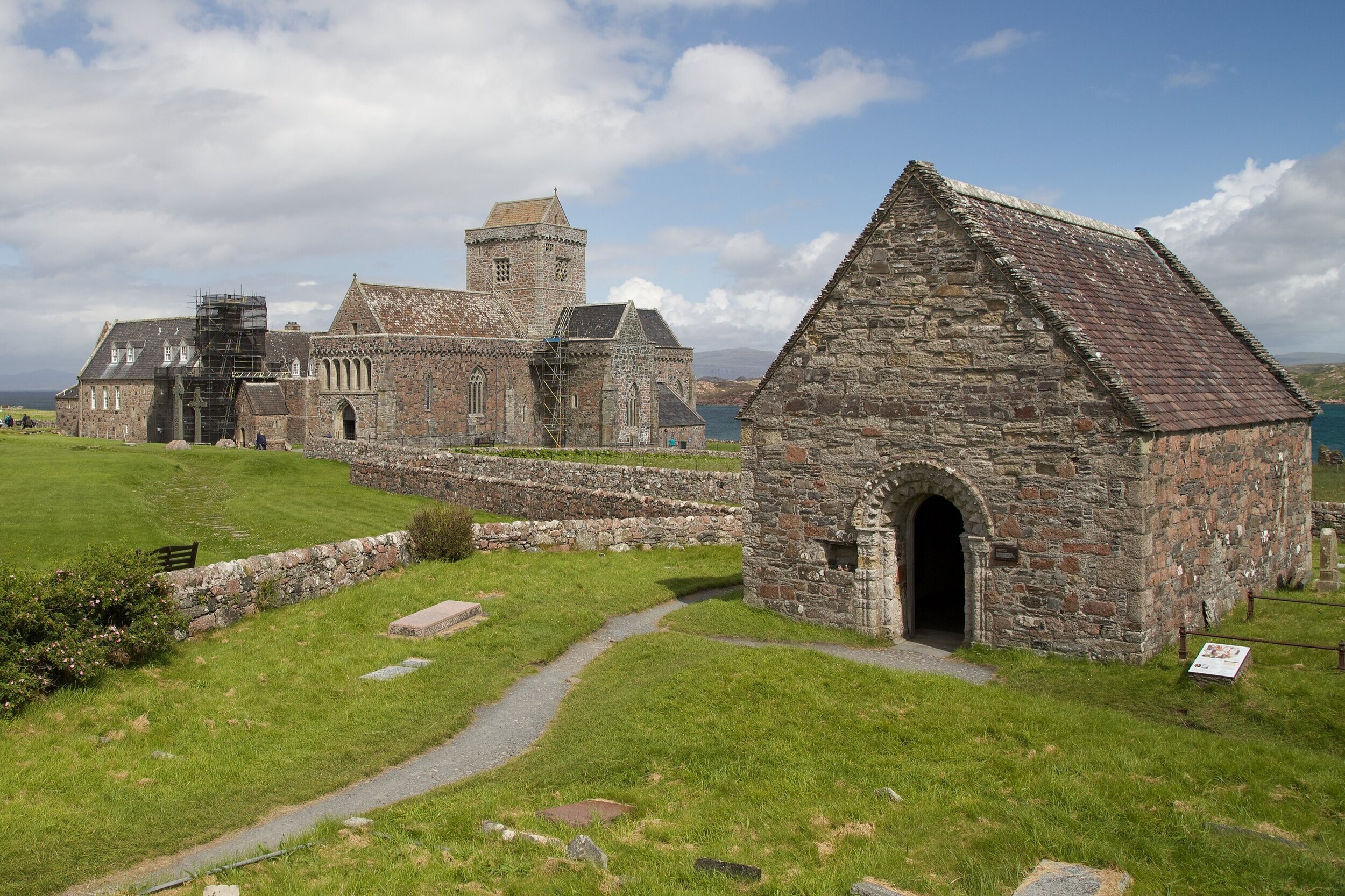Centuries of Communities on Iona
A view to the abbey on Iona
Image | Liz Lister
Iona is a small island lying off the west coast of Scotland. Measuring just four miles in length and one mile at its widest point, this is a special place. A spiritual place. A liminal place where the veil between the spiritual and the material world is thin—a threshold.
Pilgrims, travellers and tourists have been arriving here for centuries, since the time of the Celtic missionary, Columba, in the 6th century. Folktales and untrustworthy evidence suggest that Columba was banished from his native Ireland over a dispute with the Church and ordered to sail until he was no longer within sight of his beloved homeland.
What is beyond doubt is that Columba was a force to be reckoned with—a striking figure of great stature with a melodious voice that could be heard from one hilltop to another. A man of intellectual ferocity and personal charisma, he has been likened to a candle, “burning with a fierce light that guided and inspired.”
Saint Columba
Image | Tracey Christianson, St Columba Catholic Church
With this weapon in their arsenal, it’s easy to understand why the fledgling Christian church in Ireland would send him on a mission to spread the word to the pagan Picts (Celtic peoples who dwelled in the what is northwest Scotland from the time around the fall of the Roman Empire to the early Middle Ages) and Gaels occupying Dalriada—a sprawling kingdom across what we now know as Argyll on the west coast of Scotland and Antrim to the north of Ireland. Situated at the centre of the maritime highways, Iona was the perfect jumping-off point for his missions. Together with his band of followers, Columba established a small, monastic community that would have influence far beyond the confines of western Scotland.
Also known as “Crimthann” (“the fox”), Columba was as politically astute as he was charismatic and quickly gained respect amongst local tribes—a warrior monk “as proud, imperial and battle-scarred as he was scholarly and ascetic.” Stories of his “miracles” began to spread and soon a stream of pilgrims found their way to the simple monastery he and his followers had constructed on Iona. They came seeking learning or healing, refuge or absolution and through time the community grew. Iona became the preferred burial ground for the illustrious dead of Scotland. Kings and Clan chiefs as well as the monks of the Abbey and, in due course, Columba himself were buried in this most sacred shrine in Scotland.
Columba converting King Brude of the Picts to Christianity
Image | William Hole, National Portrait Gallery of Scotland, Wikimedia
Columba’s community became renowned as a place of great learning. The monastery’s library had an international reputation and its scriptorium produced highly important documents including the Book of Kells. With pilgrims came wealth, and the lure of such rich pickings proved irresistible to the Vikings, sea-faring Norse people from southern Scandinavia, who raided and traded throughout Europe and beyond.
Iona suffered cruelly through the 8th to the 10th century and the community of monks were scattered. Over time, the fortunes of the Abbey would ebb and flow like the waves on the shore. The Benedictine Abbey founded in the 12th century would be bombarded by cannon during the Reformation of the 16th century. It would emerge as the mausoleum for the Dukes of Argyll only to fall into a ruinous state where, in the absence of any secure door, cattle would wander in and out and residents of the island would rob the stone for their “new-builds.”



Finally, along came a man called George Fielden MacLeod. Born in Glasgow in 1895 into a successful and influential family (his grandfather had been chaplain to Queen Victoria), George was destined to study Law. With the outbreak of World War I, he fought in the trenches at Ypres and Passchendaele in Belgium and what he experienced there would profoundly change his outlook on life.
George Fielden MacLeod
Image | National Library of Scotland
He trained as a minister and became an assistant minister at St Giles in Edinburgh, but the inequalities that he had witnessed in the trenches were even more evident in 1920s Scotland. He took up a post in the parish of Govan, a shipbuilding area on the south bank of the River Clyde, and experienced first-hand the dire situation and social problems resulting from the high levels of unemployment, poverty and despair during the Depression.
Like Columba before him, MacLeod was an inspirational preacher and drew the adulation of large congregations. “If you listened to George MacLeod, you sat on the edge of your seat he was so good.” He soon realised, however, that these were not the working people from his parish for whom the Church had very little relevance, but rather the middle class “respectables” from further afield. Charismatic teaching did not change the lot of the poor.
He set about sharing in the lives of the people, living in community with them. A project to restore an old mill as a refuge and place of worship for the poor of Govan, would become the blueprint for a larger project in 1938—building a community of young trainee ministers and craftsmen that would live and work together to rebuild the abbey on Iona. Macleod sought to continue the legacy of Columba…a Church that could speak to all people.
In the early days, members of the community were male, and few had wives. While MacLeod was always gracious to women, but perhaps because of his military background, he held the opinion that they had no place in the community, other than in ancillary roles. However, as the men married, their wives had different views. They travelled to the island and established their own community in a summer camp some distance from the abbey, and over time they became assimilated into the decision-making process alongside their husbands.
A community that started out under the supervision of the Presbyterian Church of Scotland has evolved to become ecumenical, welcoming both men and women from all Christian faiths and those of no denominational allegiance. It has established a global reputation as a community working for peace and social justice, welcoming members of differing backgrounds from all over the world.
View from a community window
Image | Jenny Ross, Iona Community
In this special place, people come together to reflect, to worship and to be rejuvenated through community. Ideals that stand testament to the philosophy and beliefs of two exceptional men—George MacLeod and Saint Columba.





